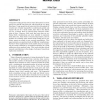Free Online Productivity Tools
i2Speak
i2Symbol
i2OCR
iTex2Img
iWeb2Print
iWeb2Shot
i2Type
iPdf2Split
iPdf2Merge
i2Bopomofo
i2Arabic
i2Style
i2Image
i2PDF
iLatex2Rtf
Sci2ools
AVI
2006
2006
Task-at-hand interface for change detection in stock market data
Companies trading stocks need to store information on stock prices over specific time intervals, which results in very large databases. Large quantities of numerical data (thousands of records) are virtually impossible to understand quickly and require the use of a visual model, since that is the fastest way for a human brain to absorb those enormous collections of data. However, little work has been done on verifying which visualizations are more suitable to represent these data sets. Such work is of crucial importance, since it enables us to identify those useful visual models and, in addition, opens our minds to new research possibilities. This paper presents an empirical study of different visualizations, that have been employed for stock market data, by comparing the results obtained by all studied techniques in typical exploratory data analysis tasks. This work provides several research contributions to the design of advanced visual data exploration interfaces.
| Added | 30 Oct 2010 |
| Updated | 30 Oct 2010 |
| Type | Conference |
| Year | 2006 |
| Where | AVI |
| Authors | Carmen Sanz Merino, Mike Sips, Daniel A. Keim, Christian Panse, Robert Spence |
Comments (0)

